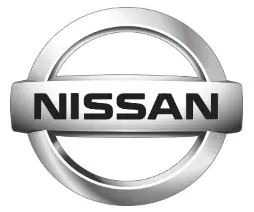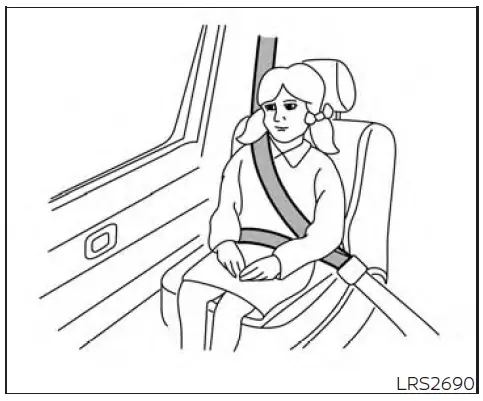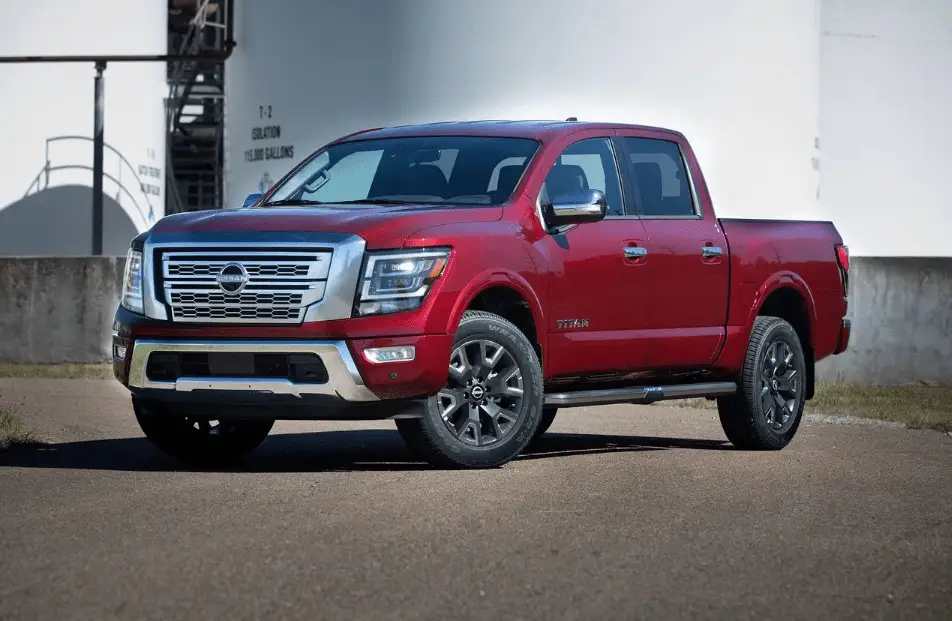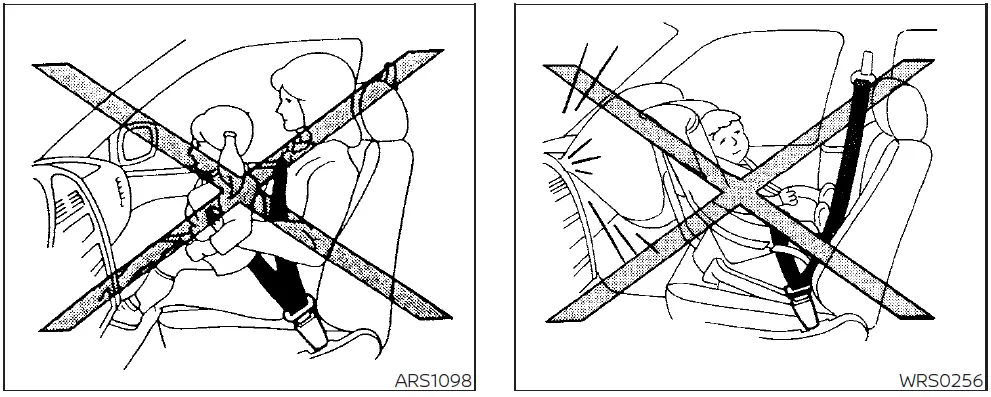
2024 Nissan Titan Owner’s Manual
The next generation of Nissan’s full-size pickup truck, which is renowned for its powerful performance and adaptability, is the 2024 Nissan Titan. The 2024 Titan is a powerful vehicle that commands attention both on and off the road. Its aggressive and tough external design includes Nissan’s iconic grille, strong LED headlights, and a robust frame built to handle rough terrain. With roomy seating and contemporary conveniences, the cabin’s interior blends comfort and functionality, making it a great option for both work and pleasure. It is anticipated that the 2024 Titan will include a variety of potent engine choices, towing capacities, and cutting-edge technology features, enhancing its standing as a serious competitor in the cutthroat full-size truck industry. For those looking for a dependable and competent pickup truck, the 2024 Nissan Titan never fails to wow with its unique combination of power and sophistication.
SEAT BELT MAINTENANCE
- To clean the seat belt webbing, apply a mild soap solution or any solution recommended for cleaning upholstery or carpet. Then wipe with a cloth and allow the seat belts to dry in the shade. Do not allow the seat belts to retract until they are completely dry.
- If dirt builds up in the shoulder belt guide of the seat belt anchors, the seat belts may retract slowly. Wipe the shoulder belt guide with a clean, dry cloth.
- Periodically check to see that the seat belt and the metal components, such as buckles, tongues, retractors, flexible wires and anchors, work properly. If loose parts, deterioration, cuts or other damage on the webbing is found, the entire seat belt assembly should be replaced.
CHILD SAFETY
WARNING
Do not allow children to play with the seat belts. Most seating positions are equipped with Automatic Locking Re-tractor (ALR) mode seat belts. If the seat belt becomes wrapped around a child’s neck with the ALR mode activated, the child can be seriously injured or killed if the seat belt retracts and becomes tight. This can occur even if the vehicle is parked. Unbuckle the seat belt to release the child. If the seat belt cannot be unbuckled or is already unbuckled, release the child by cutting the seat belt with a suitable tool (such as a knife or scissors) to release the seat belt.
Children need adults to help protect them. They need to be properly restrained. In addition to the general information in this manual, child safety information is available from many other sources, including doctors, teachers, government traffic safety offices, and community organisations. Every child is different, so be sure to learn the best way to transport your child.
There are three basic types of child restraint systems:
- Rear-facing child restraints
- Forward-facing child restraints
- Booster seats
The proper restraint depends on the child’s size. Generally, infants up to about 1 year and less than 20 lbs. (9 kg) should be placed in rear-facing child restraints. Forward-facing child restraints are available for children who outgrow rear-facing child restraints and are at least 1 year old. Booster seats are used to help position a vehicle lap/shoulder belt on a child who can no longer use a forward-facing child restraint.
WARNING
Infants and children need special protection. The vehicle’s seat belts may not fit them properly. The shoulder belt may come too close to the face or neck. The lap belt may not fit over their small hip bones. In an accident, an improper-fitting seat belt could cause serious or fatal injury. Always use appropriate child restraints.
All U.S. states and Canadian provinces or territories require the use of approved child restraints for infants and small children. A child restraint may be secured in the vehicle by using either the LATCH (Lower Anchors and Tethers for CHildren) system or with the vehicle seat belt. NISSAN recommends that all pre-teens and children be restrained in the rear seat. Studies show that children are safer when properly restrained in the rear seat than in the front seat. This is especially important because your vehicle has a supplemental restraint system (air bag system) for the front passenger.
INFANTS
Infants up to at least 1 year old should be placed in a rear-facing child restraint. NISSAN recommends that infants be placed in child restraints that comply with Federal Motor Vehicle Safety Standards or Canadian Motor Vehicle Safety Standards. You should choose a child restraint that fits your vehicle and always follows the manufacturer’s instructions for installation and use.
SMALL CHILDREN
Children that are over 1 year old and weigh at least 20 lbs. (9 kg) should remain in a rear-facing child restraint as long as possible up to the height or weight limit of the child restraint. Children who outgrow the height or weight limit of the rear-facing child restraint and are at least 1 year old should be secured in a forward-facing child restraint with a harness. Refer to the manufacturer’s instructions for minimum and maximum weight and height recommendations. NISSAN recommends that small children be placed in child restraints that comply with Federal Motor Vehicle Safety Standards or Canadian Motor Vehicle Safety Standards. You should choose a child restraint that fits your vehicle and al-ways follow the manufacturer’s instructions for installation and use.
LARGER CHILDREN
Children should remain in a forward-facing child restraint with a harness until they reach the maximum height or weight limit allowed by the child restraint manufacturer. Once a child outgrows the height or weight limit of the harness-equipped forward-facing child restraint, NISSAN recommends that the child be placed in a commercially available booster seat to obtain proper seat belt fit. For a seat belt to fit properly, the booster seat should raise the child so that the shoulder belt is properly positioned across the chest and the top, middle por-tion of the shoulder. The shoulder belt should not cross the neck or face and should not fall off the shoulder. The lap belt should lie snugly across the lower hips or upper thighs, not the abdomen. A booster seat can only be used in seating positions that have a three-point type seat belt. The booster seat should fit the vehicle seat and have a label certifying that it com-plies with Federal Motor Vehicle Safety Standards or Canadian Motor Vehicle Safety Standards. Once the child has grown so the shoulder belt is no longer on or near the face and neck and the lap belt can be positioned properly across the lower hips or upper thighs, use the seat belt without the booster seat. A booster seat should be used until the child can pass the seat belt fit test below:
- Are the child’s back and hips against the vehicle seatback?
- Is the child able to sit without slouching?
- Do the child’s knees bend easily over the front edge of the seat with feet flat on the floor?
- Can the child safely wear the seat belt (lap belt low and snug across the hips and shoulder belt across mid-chest and shoulder)?
- Is the child able to use the properly adjusted head restraint/headrest?
- Will the child be able to stay in position for the entire ride?

If you answered no to any of these questions, the child should remain in a booster seat using a three-point type seat belt.
NOTE:
Laws in some communities may follow different guidelines. Check local and state regulations to confirm your child is using the correct restraint system before travelling.
CHILD RESTRAINTS
WARNING
Never let a child stand or kneel on any seat and do not allow a child in the cargo area. The child could be seriously injured or killed in a sudden stop or collision.
PRECAUTIONS ON CHILD RESTRAINTS
- Failure to follow the warnings and instructions for proper use and installation of child restraints could result in serious injury or death of a child or other passengers in a sudden stop or collision:
- The child restraint must be used and installed properly. Always follow all of the child restraint manufacturer’s instructions for installation and use.
- Infants and children should never be held on anyone’s lap. Even the strongest adult cannot resist the forces of a collision.
- Do not put a seat belt around both a child and another passenger.
- NISSAN recommends that all child restraints be installed in the rear seat. Studies show that children are safer when properly re-strained in the rear seat than in the front seat.
- Even with the NISSAN Advanced Air Bag System (if so equipped), never install a rear-facing child restraint in the front seat. An inflating air bag could seriously injure or kill a child. A rear-facing child restraint must only be used in the rear seat.
- Be sure to purchase a child restraint that will fit the child and vehicle. Some child restraints may not fit properly in your vehicle.
- Child restraint anchorages are designed to withstand only those loads imposed by correctly fitted child restraints. Under no circum-stances are they to be used to attach adult seat belts, or other items or equipment to the vehicle. Doing so could damage the child restraint anchorages. The child restraint will not be properly installed using the damaged anchorage, and a child could be seriously injured or killed in a collision.
- Never use the anchor points for adult seat belts or other items.
- A child restraint with a top tether strap should not be used in the front passenger seat.
- Keep seatbacks as upright as possible after fitting the child restraint.
- Infants and children should always be placed in an appropriate child restraint while in the vehicle.
- When the child restraint is not in use, keep it secured with the LATCH system or a seat belt. In a sudden stop or collision, loose objects can injure occupants or damage the vehicle.
CAUTION
A child restraint in a closed vehicle can become very hot. Check the seating surface and buckles before placing a child in the child restraint.
This vehicle is equipped with a universal child restraint anchor system, referred to as the LATCH (Lower Anchors and Tethers for CHildren) system. Some child restraints include rigid or webbing-mounted attachments that can be connected to these anchors. If you do not have a LATCH-compatible child restraint, the vehicle seat belts can be used. Several manufacturers offer child restraints for infants and children of various sizes. When selecting any child restraint, keep the following points in mind:
- Choose only a restraint with a label certifying that it complies with Federal Motor Vehicle Safety Standard 213 or Canadian Motor Vehicle Safety Standard 213.
- Check the child restraint in your vehicle to be sure it is compatible with the vehicle’s seat and seat belt system.
- If the child restraint is compatible with your vehicle, place your child in the child restraint and check the various adjustments to be sure the child restraint is compatible with your child. Choose a child restraint that is designed for your child’s height and weight. Always follow all recommended procedures.
- If the combined weight of the child and child restraint is less than 65 lbs. (29.5 kg), you may use either the LATCH anchors or the seat belt to install the child restraint (not both at the same time).
- If the combined weight of the child and child restraint is greater than 65 lbs. (29.5 kg), use the vehicle’s seat belt (not the lower anchors) to install the child restraint.
- Be sure to follow the child restraint manufacturer’s instructions for installation.
All U.S. states and Canadian provinces or territories require that infants and small children be restrained in an approved child restraint at all times while the vehicle is being operated. Canadian law requires the top tether strap on forward-facing child restraints to be secured to the designated anchor point on the vehicle.
FAQs
Key updates for the 2024 Nissan Titan may include design changes, technology enhancements, and improvements in performance and towing capacity.
The 2024 Titan typically offers seating for up to five passengers in its crew cab configuration.
The 2024 Titan is expected to offer a range of engine options, which may include V6 and V8 engines with varying power outputs.
Yes, the Titan usually offers both rear-wheel drive (RWD) and four-wheel drive (4WD) options to cater to different driving needs.
The 2024 Titan is expected to come equipped with a suite of safety features, including advanced driver assistance systems like adaptive cruise control, lane departure warning, and automatic emergency braking.
The starting price for the 2024 Titan will depend on its trim levels and available options, but it is expected to be competitive within the full-size truck segment.
Yes, the 2024 Titan is expected to come equipped with an advanced infotainment system, including a touchscreen display, smartphone integration, and connectivity options.
Yes, the 2024 Titan typically offers various trim levels, including base models and higher-trim versions with additional features and options.
Fuel economy figures for the 2024 Titan will depend on the engine and configuration, but full-size trucks like the Titan tend to prioritize power and capability over fuel efficiency.
Yes, the 2024 Titan is expected to have a spacious and comfortable interior with ample room for passengers and cargo.
Yes, the 2024 Titan is expected to offer advanced towing and payload capabilities, making it suitable for various towing and hauling needs.
Nissan may consider introducing hybrid or electric variants of the Titan in the future as part of their electrification efforts, but availability depends on their product strategy.
The 2024 Titan typically offers different bed lengths, including short bed and long bed options, to accommodate different cargo requirements.
The 2024 Titan typically comes with a standard manufacturer’s warranty, which includes coverage for a specified period or mileage.
The price of the 2024 Nissan Titan starts at $47,665 and goes up to $61,335 depending on the trim and options.
Useful Link
DownloadManuals:https://www.nissanusa.com/owners/ownership/manuals-guides.html
2023 Nissan Titan Specs, Price, Features and Mileage (Brochure)


